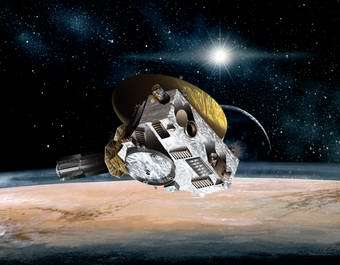Deadline Extended For Pluto Mission Digital Time Capsule

New Horizons - launched in January 2006 on a nine-year journey to Pluto - is leaving behind an Earth that will not be the same when the spacecraft arrives at its destination in 2015.
The Planetary Society, in conjunction with the New Horizons mission, announced a contest at the time of launch, inviting children and adults around the world to send a message to future Earth - a New Horizons Digital Time Capsule from Earth today to the inhabitants, who will witness the spacecraft arrive at Pluto nearly a decade later. The New Horizons Digital Time Capsule will consist of photographs of things in 2006 that people expect will be transformed by 2015.
Already changes have taken place in the Digital Time Capsule contest itself. The Planetary Society is now extending the contest deadline from July 15 to Nov. 1, 2006, and is offering a grand prize trip to New Horizons mission control at the John Hopkins University Applied Physics Laboratory to witness the Jupiter fly by in February 2007.
What will Earth be like in 2015? How will life on our planet have changed in those intervening years? More than a billion people will be born, and a billion die; new technologies could revolutionize daily life; the rapid pace of change will have transformed not only our own lives but also that of cities and entire countries. Earth will have discovered other new horizons while the New Horizons mission cruised through interplanetary space.
"Anyone, young or old, who can point a camera and say 'I think this will change' can submit an entry for the Digital Time Capsule," said Bruce Betts, The Planetary Society's director of projects. "We are encouraging people to think positively, too, to offer examples of things they hope will change for the better."
The New Horizons Digital Time Capsule will be placed on a DVD and kept securely at Planetary Society Headquarters in Pasadena, California, with a backup copy stored with the New Horizons project. As the spacecraft approaches its rendezvous with Pluto, it will send back a "family portrait" of the Pluto system.
The return of this image from the spacecraft will be used as the signal for the time capsule to be opened and shown to Earth in 2015. As we see a close up family portrait of Pluto and its moons, we will also be able to look back on the images of Earth as it was when New Horizons began its journey.
Anyone may enter, but only one entry per person or per group is permitted. An entry consists of a photo, accompanied by a caption, of something that is likely to change between now and 2015.
The photo can be of anything, including (but not limited to) landscapes, buildings, technological devices, vehicles, living things, etc. The deadline for entries is November 1, 2006. Complete rules and sample images can be found at
planetary.org/explore/topics/time_capsule/
An international panel of judges selected by The Planetary Society will review the submissions. The panel will select a representative set of up to 100 photos for the New Horizons Digital Time Capsule, based upon the perceived likelihood that the subject of the photo will change over the next nine years, the aesthetic quality of the photograph, and the originality of the subject.
Everyone whose photos are selected for the Digital Time Capsule will be entered into a random drawing. The winner will win a trip to the Applied Physics Lab in late February 2007, to be present when New Horizons encounters Jupiter en route to Pluto. In the event that the winner is under 18, the prize will become a trip for two so that a guardian can accompany the winner. See complete prize rules on The Planetary Society's website.
After New Horizons crosses Jupiter's orbit, the time capsule will be closed. It will not be reopened until the spacecraft arrives at Pluto in 2015. The time capsule will be opened when the Pluto family portrait is returned shortly before the Pluto encounter.
New Horizons, the first of NASA's New Frontiers missions, will not only complete our "tour" of the planets, but will also increase our understanding of the composition of the solar system and its origins.
The outer reaches of the solar system are very different from the better known regions occupied by the four terrestrial planets and the four gas giants. Billions of miles from the Sun, Pluto orbits among the vast field of rocky and icy debris known as the Kuiper belt. After a flyby of Pluto and its moons Charon, Nix, and Hydra, New Horizons will continue its flight and visit at least one other Kuiper belt object.
Copyright 2006 by Space Daily, Distributed United Press International





















